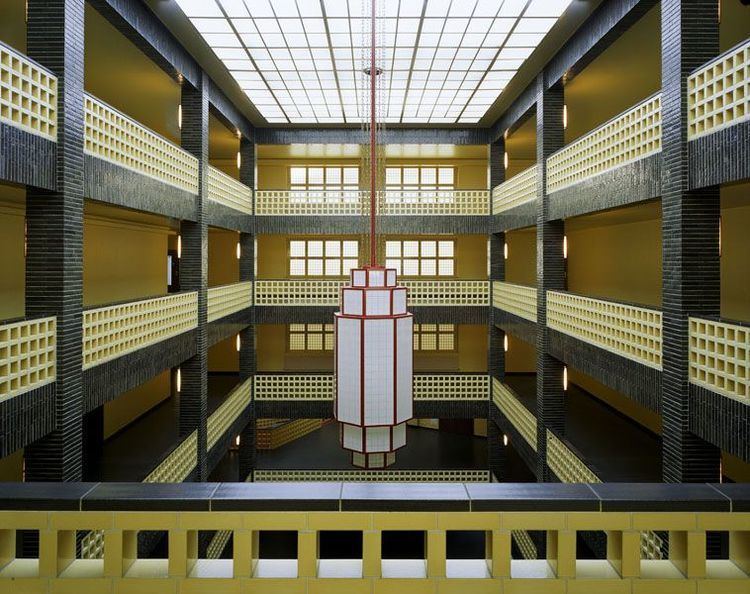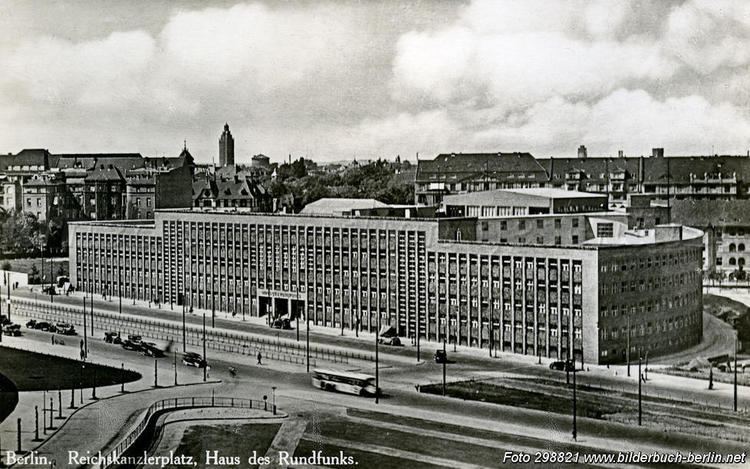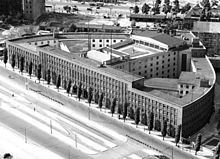Opened 1930 Construction started 1929 | Completed 1930 | |
Address Masurenallee 8-1414057 Berlin Similar Internationales Congress Centrum, Funkturm Berlin, Großes Schauspielhaus, Berlin Messe Nord/ICC, Deutschlandhalle | ||
Haus des rundfunks and funkturm birthplace of german tv
The Haus des Rundfunks ("House of Broadcasting"), located in the Westend district of Berlin, Germany, is the oldest self-contained broadcasting house in the world. It was designed by Hans Poelzig in 1929 after winning an architectural competition. The building vis-à-vis the Funkturm contains three large broadcasting rooms located in the centre, shielded from street noise by the surrounding office wings. It is now used by the local ARD broadcaster Rundfunk Berlin-Brandenburg (RBB) and produces radio programs for the channels radioBerlin, Kulturradio, and Inforadio. The building's broadcasting rooms are occasionally also used to host concerts.
Contents
- Haus des rundfunks and funkturm birthplace of german tv
- Susan philipsz you are not alone haus des rundfunks berlin 2011
- History
- The building
- References

Susan philipsz you are not alone haus des rundfunks berlin 2011
History

The building, designed with a plan shape of a rounded triangle with a 150 m (490 ft) long façade of ceramic tiles, was constructed from 1929-1930 and inaugurated on 22 January 1931 as the seat of the Reichs-Rundfunk-Gesellschaft. The large, central broadcasting room was finished in 1933. On the 22 March 1935 the first regular television service in Germany Fernsehsender Paul Nipkow was started here, but moved to a separate building on nearby Theodor-Heuss-Platz in 1937. The Haus des Rundfunks also had an important influence on the development of stereophonic sound and its adoption to broadcasting. Some radio programming continued during the war, notably the Wunschkonzert für die Wehrmacht ("Request Concert for the Armed Forces"), broadcast from the Haus des Rundfunks on Sunday afternoons from 1939 to 1941.

After World War II, the Haus des Rundfunks became something of a Cold War issue: Though it was situated in the British Sector of West Berlin, it was used by the Berliner Rundfunk radio station, controlled by the Soviet occupation forces, until it moved to East Berlin in 1952. Not until 5 July 1956 the building was handed over to the West Berlin mayor Otto Suhr by the Soviet military command. After considerable renovation work, it was used from the end of 1957 as the home of Sender Freies Berlins broadcasting programmes, which on 1 May 2003 merged into the Rundfunk Berlin-Brandenburg.
The building

The Haus des Rundfunks was one of the first buildings in Europe solely dedicated to broadcasting, exceeded in age only by the Münchner Funkhaus. It is thus especially noteworthy that the building still offers ideal conditions for broadcasting productions today. At the time, Hans Poelzig had almost no examples to emulate, but he developed ideas which are still valid today: the office and editorial rooms are located on the outer areas of the building and surround the three large studio complexes. The largest broadcasting room comprises the heart of the building, and aside from this there is also a smaller broadcasting room and an area for radio dramas which possesses a diversity of acoustic characteristics.

Poelzig put a great deal of thought into the acoustics of the rooms. The chairs in the large broadcasting room were specially designed so that seats had the same sound-absorbing qualities whether they were occupied or not. In the smaller broadcasting room a hundred wall panels could be flipped. One side of the panels absorbed sound, the other reflected it. In this way very different reverberation effects could be created.
